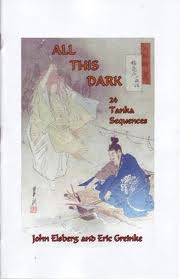Book Review
John Elsberg and Eric Greinke, All This Dark, 24 Tanka Sequences, Červená Barva Press, 2012
Reviewed by Judy Swann
A number of successful holy books are the product of poetic collaboration, but not much successful poetry has resulted from a shared spiritual stance. So I approach the collaboration of John Elsberg and Eric Greinke in All This Dark with wariness. But there don’t seem to be any cracks—the collaboration is so complete that I don’t really even wonder which poet is responsible for which bits and what the mechanics of collaboration were. Moreover, leaving the collection, our busy minds are at one with what we have just read. Whether the book’s gift of connectedness comes from the quality of the poets’ soul or their freewheeling re-definition of tanka, or is akin to Rupert Sheldrake’s morphic resonance, I cannot say. But it feels like success.
The poems are not classical tanka, but reinventing a classical form is no crime. If they had plugged our Anglo-Saxon monosyllables into classical tanka form like so many spondees, the work would not have been capable of the bongo beat and finger click that these smoky gems achieve. In “Commodities,” we read:
gold hands
platinum undershirt
uranium heart
the masters of Wall Street
have been touched
and we are left to complete the picture. Here’s mine: King Midas in Bruce-Willis-underwear monstrously pops and crackles himself into Frankenlord. What’s yours? “Commodities” second stanza shows us:
the sly quiet
of a weekday morning
in the suburbs
just this drifting lullaby
mower to the grass
The metals of the megacity are set against industrial pastoral and readers are left to piece things together, as they will. Elsberg and Greinke do not interpret for them.
What they do is marry the darkness to the light over and over again, mostly as images, as we have seen above, but also as existential thesis. Take the poem “Memory”:
sorting through
so many lonesome poems
in my files
can’t find the ones I want
can’t remember the sounds
In this sequence, the middle line is the anchor completing the thought of the first two lines and situating the final two. Wordsworth’s loneliness runs to Williams’ thinginess runs to isolation more absolute. Why have the sounds been obscured? Is life just one long act of sorting through? No one can give you that answer.
“Flotsam” represents a third thread in All This Dark, the audio thread. Read this out loud:
seeds scatter freely
in the soggy spring breezes
but I am asleep
beneath a tall pine tree free
to float on my bay of dreams
Is that bay a horse? I like to think of the author (I always think of them as a single person) bounding away on his mare, heroic, long hair waving in the humid breeze. Probably the bay is a body of water, but I am able to champion the horse because no bullying author forces me to abandon it. Moreover, for me, the unvoiced fricatives of the beginning that morph into the voiced labials of the close on a bed of long ease, er, eee’s just feels good in the mouth. My hero is this dreamer, in any case, and I think he will be yours, too, once you read the entire collection.
Judy Swann lives in gorgeous Ithaca, NY in a small house painted in Frida Kahlo colors. Her poetry has appeared in Lilliput Review, Verse Wisconsin, Soundzine and other places both in print and online. She is an Iowan who often visited Wisconsin in her youth.


